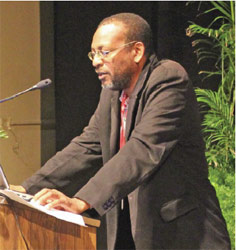|
June 2015

Issue Home >>
|

 Lifting the burden of disability and therefore positively impacting on the future of disability requires that we see ourselves differently and acknowledge the inherent flaws of the human condition. Disability is as much a biological reality as it is a social construction. A recent story about the delayed reopening of the School for the Blind in Santa Cruz implied that because the children were blind, the officials at the Ministry of Education were less than dedicated to seeking the best interest of the children and the school. Ironically the building of the Blind Welfare Association has also been closed for repair for an inordinately long period of time. Lifting the burden of disability and therefore positively impacting on the future of disability requires that we see ourselves differently and acknowledge the inherent flaws of the human condition. Disability is as much a biological reality as it is a social construction. A recent story about the delayed reopening of the School for the Blind in Santa Cruz implied that because the children were blind, the officials at the Ministry of Education were less than dedicated to seeking the best interest of the children and the school. Ironically the building of the Blind Welfare Association has also been closed for repair for an inordinately long period of time.
It would appear that people with disabilities function at the margin of society, objects to be pitied, derided or laughed at, sometimes all at once. Our Immigration Act Section 7.2 speaks to prohibiting from entry to the country: idiots, imbeciles, feeble minded, dumb, deaf, blind and those who would be a charge on public funds. How this judgment is made and how it affects those who are disabled when they travel is unclear.
Oscar Pistorius has made the leap from disabled to abled (some reporters say super abled) because of technology. With his blades for legs, he competed against non-disabled athletes at the London Olympics and reached the finals of the 400 metre race after being a successful paralympian. He described being anxious and self conscious when he was at home with himself and the blades came off. He also said that he felt embarrassed when people saw him without his prosthetic legs. He had a congenital disease that caused him to have both of his legs amputated above the knee in early childhood. Technology whether it be prosthetics, robotics or simulation will eventually overcome the physical effects of disability but how does it remove the self adduced sense of being inferior, less than, looked at, marginalized and of course stigmatized as a result.
Neurodiversity is one concept that might address that. Neurodiversity, a term coined by Judy Singer, is defined as atypical neurological wiring being viewed as an acceptable form of human difference just like age, class or gender. It arose out of her research on autism. Being neurologically different then and being seen as such should not be a basis for prejudice or disadvantage. It should be seen as a unique way of being; not a disease to be cured. However as the example of Oscar Pistorius demonstrates, the perception of disability is internalized by those so affected and is difficult to overcome. This is especially so when the disability is something visible.
Even when it is not visible as in mental illness, it becomes socially isolating. John Derby, analysing the visual representations of madness from antiquity to the present, highlights three common threads. Paternalism, ableism and speciesism – these represent the sense that people with mental illness need to be taken care of, are not able to function in life like everyone else and are not quite human when they are ill. This sense of not quite human explains the popular and ongoing propensity to suggest that mental illness is a form of demon possession. Derby argues that these perspectives on the mentally ill act to justify multiple overt and subtle forms of oppression that may be sometimes masked as care. Identifying mental illness as disability creates a shift in meaning for the treatment of those so diagnosed. Although they might appear to be physically healthy, their inability to meet societal expectations for behaviour and productivity become justification for social isolation and stigmatization. It is a delicate line to draw and tread. The provision of services and support for those with mental disorders juxtaposed with providing the encouragement to function as individuals, can enable them to take full responsibility for their lives.
Erich Fromm in his book “To Have or To Be” suggests that the choice of possessions and material well being over self actualization and self awareness is the fundamental problem of the modern world. The concept of disability is primarily informed by the inability to be as productive as the non-disabled, meaning the inability to have. However we all have the capacity to be and we all have to deal with our internal and unseen disabilities in order to fulfill that capacity to be. The burden that people with disabilities are made to carry is a by-product of the inability of those who do not believe they are disabled to look inside themselves and accept that we are all flawed in one way or another. The need to engage with others’ weaknesses with compassion and respect, not judgment or discrimination, is paramount if we are to continue to live with ourselves. The survival of our species depends on our capacity to accept difference, including those who are neurologically different.
This is a modified version of a paper presented by Professor Gerard Hutchinson at a conference hosted by The UWI Network and Outreach for Disability Education and Sensitization (NODES) and the Disability Studies Unit (DSU), UWI, St Augustine on April 23 and 24, 2015. The conference theme was “Towards Social Integration: Rights, Roles, Recognition of Persons with Disabilities.” |





